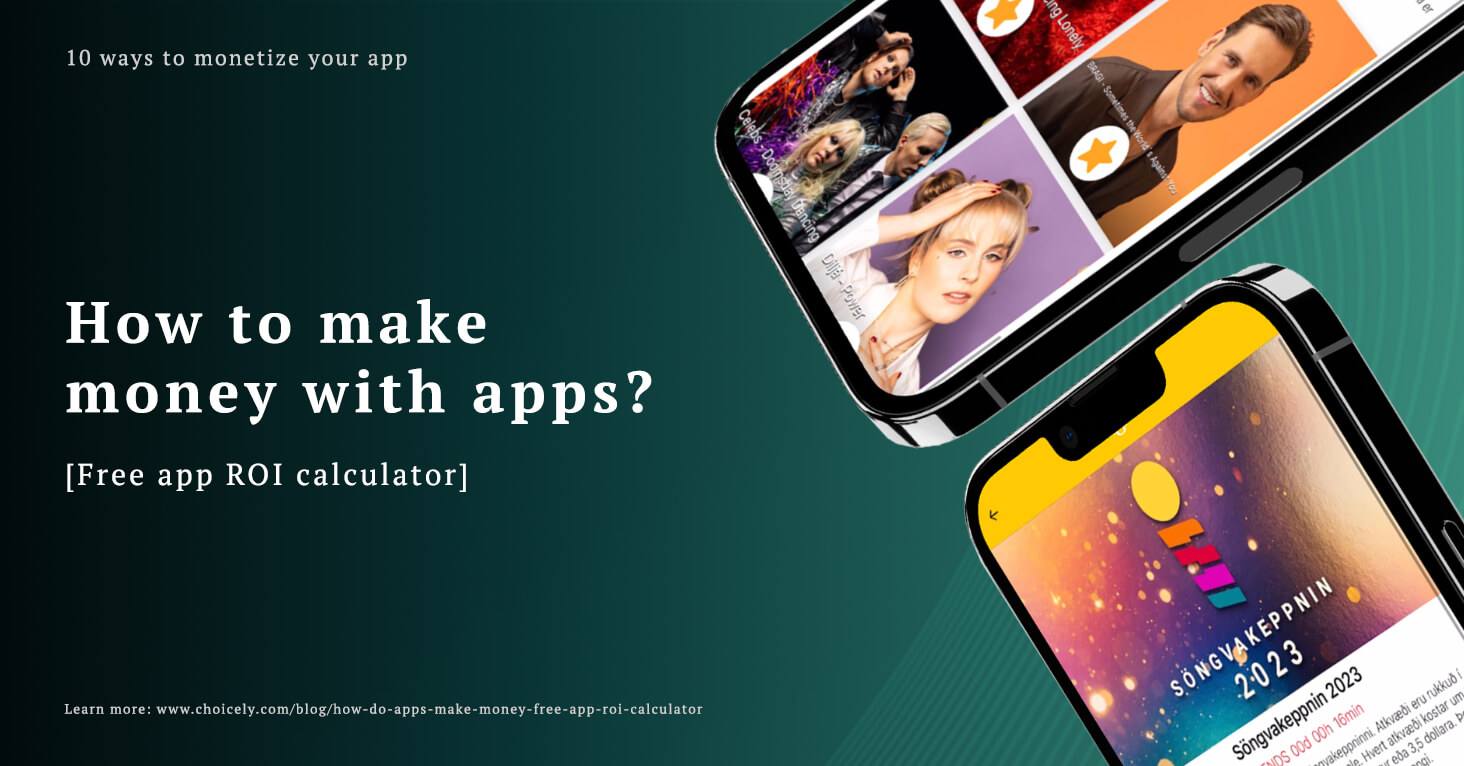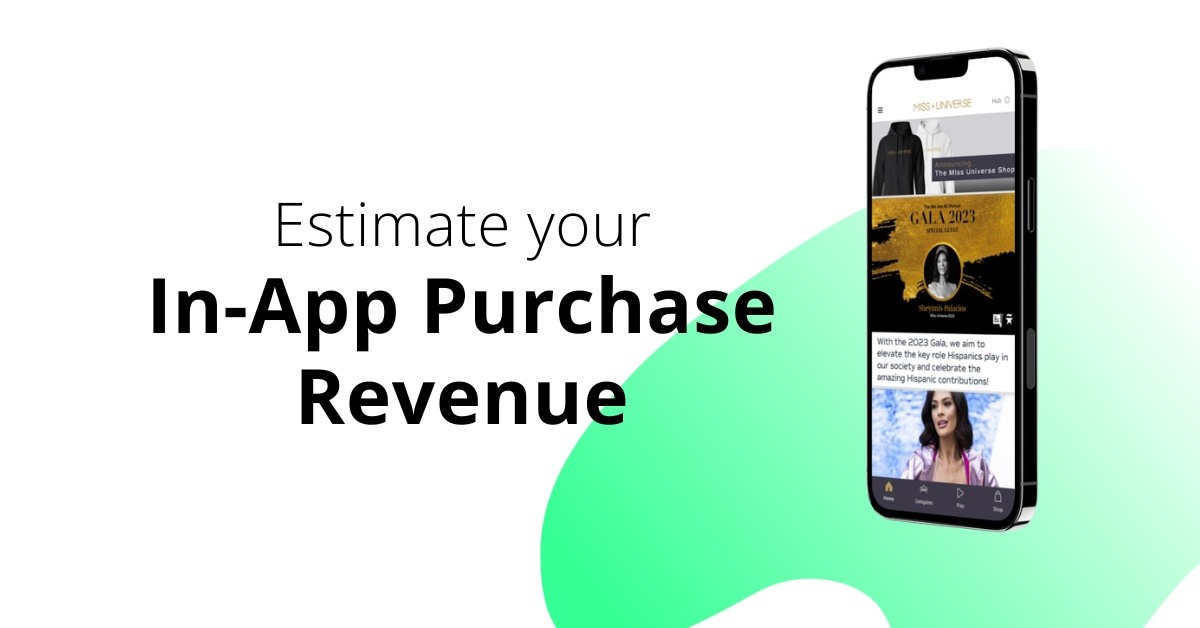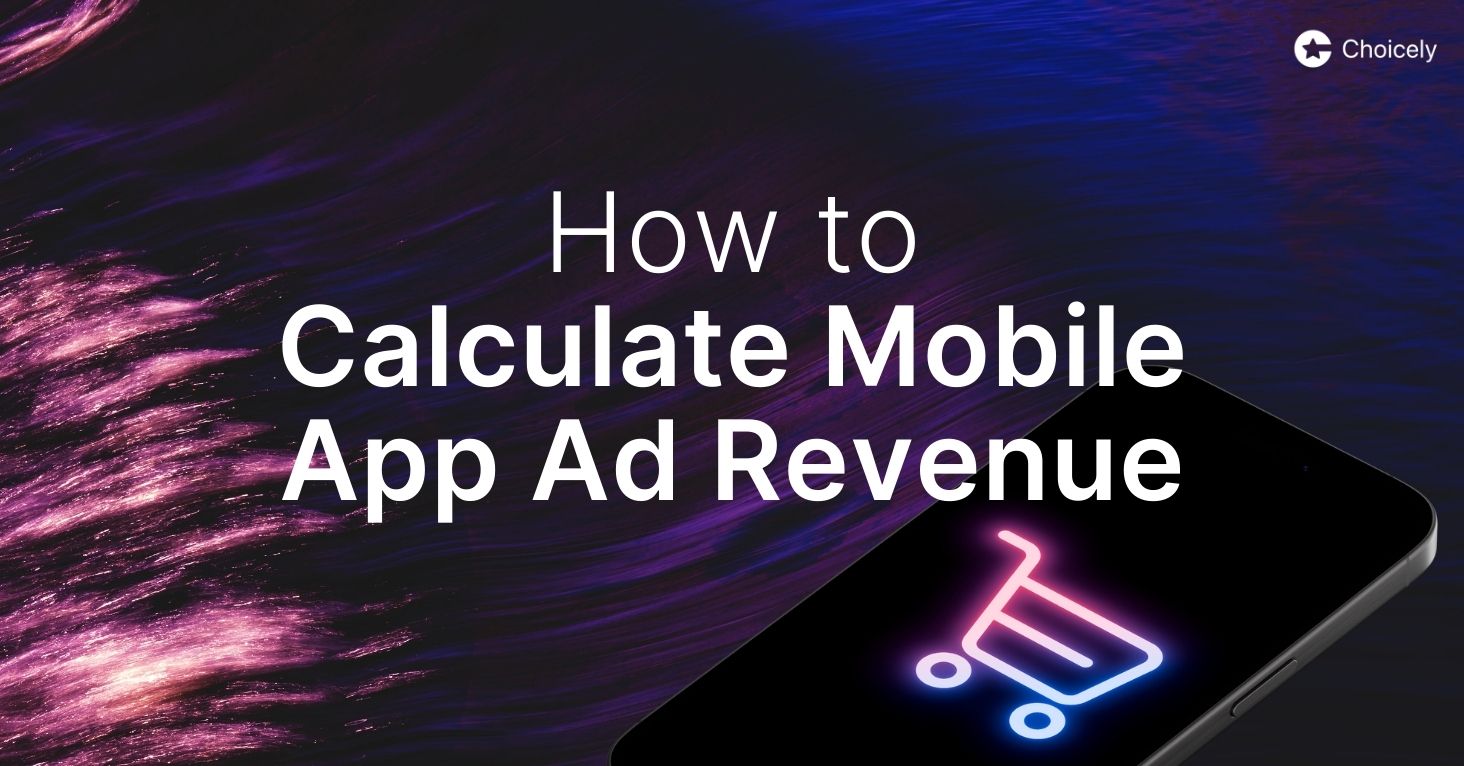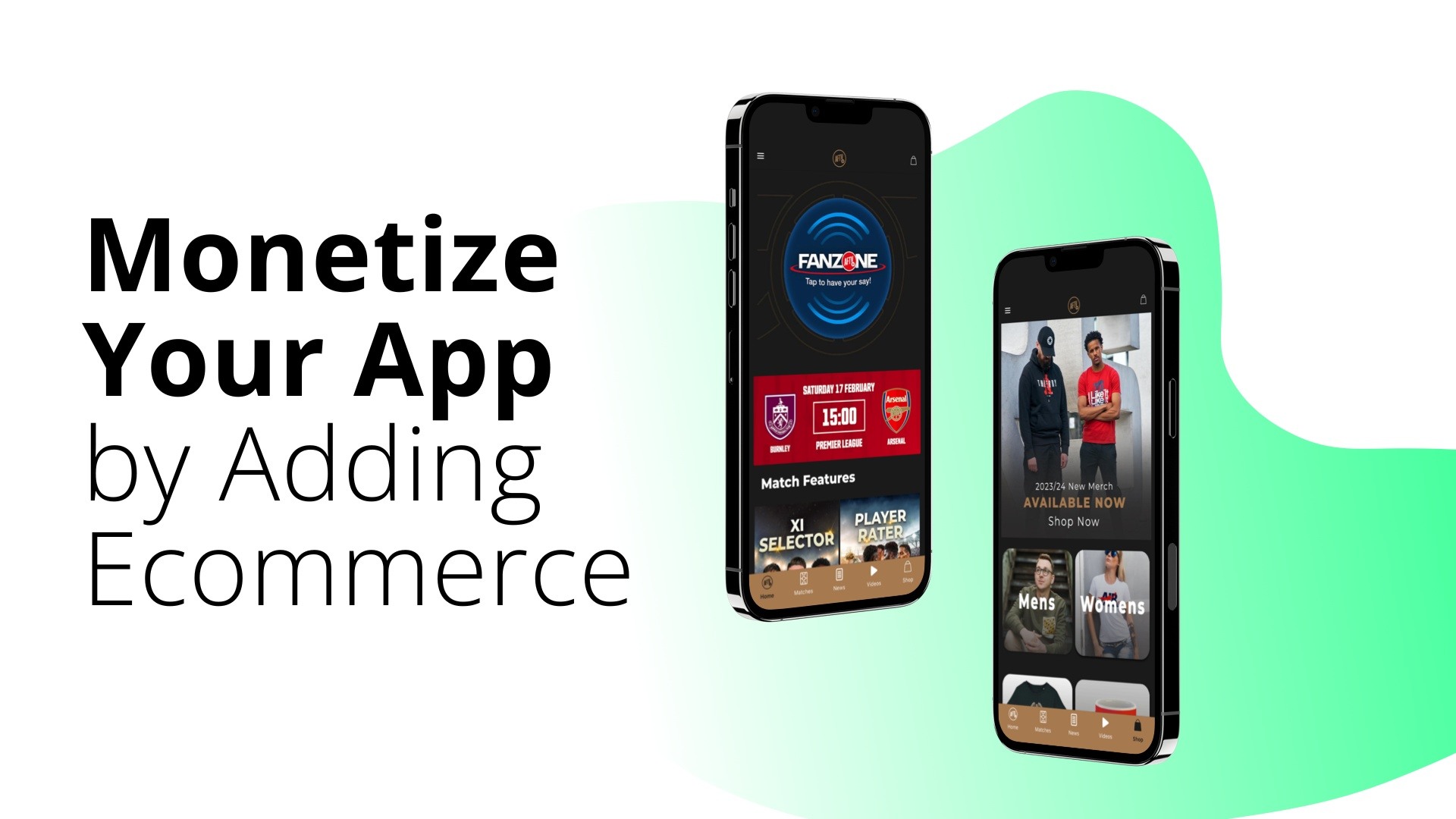app development

How to Generate Revenue From Apps [App Monetization Calculator]
How to grow your revenue with mobile apps? In this blog post, you will learn different ways to monetize your app and generate revenue for your business.
Kaius, CEO
Jun 14, 2023

Have you thought about getting an app for your business? The case for apps is certainly compelling as an average phone user spends 4,5 hours a day on apps, globally.
Apps have multiple use cases too: from communication and entertainment to shopping and education.
But how do apps actually generate revenue? In this blog post, we'll help you understand different app monetization models and find the ones that suit your business the best.
We’ll also discuss how you can calculate your estimated revenue, app costs, profit and ROI – so you can make an informed business decision on investing into a branded app.
Whether you're an entrepreneur, an app developer, a marketer or someone else – understanding these monetization models will enable you to make wise decisions and improve the chances of success for your app.
Want to start making your own calculations?
Check out our free Google Sheet below – you can calculate revenue for different app monetization models, and estimate app costs, profit and ROI. Just make a copy of it for yourself first to edit it!:
Contents
Want to quickly hop into a section? Click the links below!
Intro: How to generate revenue with mobile apps
2. Sponsorships and partnerships
4. Freemium app with paid content
6. Loyalty app, or giving out offers and coupons
7. Ecommerce app or Ticket sales
10. App for a physical store or location
How to calculate how much money you’ll make with apps
The cost of mobile app development
Calculating the return on investment (ROI) of your app
How to generate revenue with mobile apps
A solid app monetization model determines in the first place if an app can be a moneymaker for your business.
To begin with, you'll need to think about who your app is for, what it does, and what sets it apart from other apps.
Finding the right monetization model is one of these foundational ideas for your app, and there are a few different ways to do it.
Here's a rundown along with simple ways to calculate how much revenue you can make with each app monetization model:
1. In-app advertising revenue
Providing your app as an advertising platform to generate in-app advertising revenue is one of the most popular ways for apps to earn revenue. Ads can appear in different formats, like banner ads, interstitial ads, native ads, and rewarded ads. With so many people using apps every day, advertisers are keen to pay app developers to display their ads within the app.
This monetization model is recommended when you have a very large audience that you reach with your app. For an app with a smaller audience this could work as a complementary stream of income.
If you decide to host ads in your app, make sure that the number of ads doesn't ruin the user experience. Bombarding users with too many ads can irritate them and lead to them deleting your app. On the other hand, dedicate enough space for ads to generate enough revenue for you. Find the right balance and ensure that ads are relevant to the app's content and users.
How to estimate your revenue with app advertising
To estimate revenue from advertising, you'll need to estimate the number of active users, how much time they spend in the app, and the amount of revenue you’d make for your ads. The common metric for this is revenue for a thousand impressions (Revenue Per Mille, RPM).
A simplified formula for total ad revenue is Ad impressions / 1000 x Revenue Per Mille.
Check out our more detailed blog post on calculating estimated in-app ad revenue for your app.
Ad impressions is the total amount of ads shown and it depends on the number of active users in the app, average time spent per user, and how many ads are shown per minute.
Revenue Per Mille can vary a lot, for example depending on the type of ads you’ll host within your app. There are also multiple other factors like your audience and the demand of your app as an ad platform.
2. Sponsorships and partnerships
Sponsorships and partnerships are some of the most important income sources for sports organizations, athletes, artists and events. This approach involves teaming up with another business to promote their products or services within your app. For example, a sports app owner could collaborate with a brand and give them visibility or even showcase their product discounts.
Sponsorship deals can be very profitable. However, it's vital to make sure the partnership is a good fit for your app and your users. It’s also the sponsor’s benefit: that their offering and your audience are a good match. Choose your partners carefully and make sure that the partnership adds value to your users.
Read more tips on how to succeed with app sponsorships.
How to estimate your revenue with app sponsorship
To estimate revenue from sponsorships, you basically need to consider the number of sponsorships and the value of each sponsorship.
You can use this formula: Total sponsorship revenue = Number of sponsorships x Value of each sponsorship.
Or just simply add up the value of your potential app sponsorships. For example, you could have one main sponsor for the app, dedicated sponsors for certain fan activations, or give your sponsors dedicated space throughout the app, potentially as a part of a bigger sponsorship package.

3. In-App Purchases
In-app purchases offer users additional features, virtual goods, or subscriptions within the app for a fee. You can also offer a digital way to buy physical products using in-app purchases. More on that under the headline “10. App for a physical store or location”.
In-app purchases can be a great way to generate revenue for many kinds of businesses, and most famously for gaming apps. However, it's important to ensure that the purchases are not necessary for the basic use of the app and that users are aware of the costs upfront.
Pricing is also a very important factor, here’s a great article on in-app purchase pricing.
How to estimate your revenue with In-App Purchases
To estimate revenue from in-app purchases, you'll need to consider the number of active users and the average revenue per user (ARPU) from in-app purchases.
You can use one of these formulas:
1) Total in-app purchase revenue = Total users (in a given timeframe) x Conversion-% to paying customers x Average Purchase per Customer ($)
2) Total in-app purchase revenue = Active users x Average Revenue Per User (ARPU)
According to different sources, the install-to-purchase conversion can range around 1-2% to 5,5% (within the first 30 days of app install). The average spend of an app user is 0,50 dollars per month.
Learn more about estimating the In-App Purchase revenue of your app in our detailed article.

4. Freemium Model (with upgrades to premium content)
Many businesses offer their app initially for free, but charge users for additional features or premium content within the app. The idea is to provide enough value for users to download and use the app without paying, and entice them to pay for premium features or content to enhance their experience.
Make sure that the free version of the app provides value to keep users engaged and interested in upgrading to the premium version. Also, premium content should be a good deal for the advanced users that end up paying for it.
Make sure you have enough resources to update and produce value for both sides of the app: free and paid.
How to estimate your revenue with Freemium Model
To estimate revenue from the freemium model, you'll need to consider the number of active users, the percentage of users who upgrade to the premium version, and the price of the premium version.
You can use this simplified formula: Total freemium revenue = Active users x Percentage of users who upgrade x Price of premium version.

5. Subscription Model
The subscription model involves offering users access to exclusive content or features within the app for a recurring fee. This model is often used by apps that provide ongoing value, such as news or streaming services.
Provide a reasonable subscription fee and give users enough value to justify the recurring cost. A free trial period can also help convert users to sign up for the subscription service.
How to estimate your revenue with Subscription App Model
To estimate revenue from the subscription model, you'll need to consider the number of subscribers and the monthly subscription fee.
Use this simple formula: Total subscription revenue = Number of subscribers x Monthly subscription fee.
According to Statista, 2,1% of non-gaming app users subscribe within the first 30 days of usage.

6. Loyalty app, or giving out offers and coupons
Loyalty apps ae used for encouraging user loyalty by offering discounts, coupons, or other incentives to users as rewards for their loyalty.
Build a strong and dedicated user base by providing heaps of value to your users, such as relevant offers and rewards. Track the success of your program and make changes as necessary to ensure that it's generating revenue for your app.
How to estimate your revenue with a Loyalty app
To estimate revenue from a loyalty app, you'll need to consider the number of active users and the value of the rewards you offer.
Here’s a simplified formula for a loyalty program: Total loyalty revenue = Loyalty app users x Average Revenue Per User x Customer relationship in years
It always makes sense to take income and costs from a longer time frame into account. This applies especially to loyalty programs where the value of the program aims towards long term customer relationships and returns.
When calculating the costs of the loyalty program, also remember to take the cost of rewards and discounts into account.
Learn more about calculating the ROI for your loyalty program.

7. Ecommerce app or Ticket sales
Apps are engaging platforms where users can spend a lot of time. Imagine having the ability to give them a way to buy products without leaving your app. That's what this model is all about.
Uers can purchase all kinds of physical or digital products directly from an ecommerce app, whether it's merchandise, other physical products, or tickets to events or experiences.
If you already have an online store, this is a natural way to get closer to your customers – just add your ecommerce store in your app.
To make this model work, it's important to ensure that the purchasing process is smooth and easy for users. The app should also provide a secure platform for payments to ensure user trust.
How to estimate your revenue with using your for Ecommerce and Ticket sales
To estimate revenue from ecommerce, merchandise, or ticketing, you'll need to consider the number of sales and the average revenue per sale.
You can use this formula: Total revenue = Number of Active users x Conversion rate to Sale x Average revenue per sale.
For benchmarking, a typical mobile commerce (“MCommerce”) conversion rate varies around 1,5 to 2%. Calculate your MCommerce App revenue on our Sheet.

8. App as a marketing channel
An app is a great way for marketers to engage with their audience. In this model, the app works as a tool for marketing communications and promoting products or services. This can include distributing content, conducting surveys, or hosting contests to engage users and encourage them to interact with the brand.
To succeed with this model, it's important to offer valuable and relevant content that aligns with the interests of the target audience. The engagement tools should be easy and provide a positive user experience, and they should be designed to encourage user participation and sharing.
How to estimate your revenue with using your app as a marketing channel
When the primary purpose of your app is brand marketing: generating engagement, affinity and loyalty with your brand, the app’s effect on revenue can be hard to attribute.
You can instead estimate the value of your app as an alternative to media investments – calculate the value of the engagement if it was achieved through other means like paid media. You'll need to consider the number of users who engage, and how long they engage with the content.
You can use this formula: Value of the engagement in another media = Total time spent on the app / Average time spent per session in the alternative media x Cost per session.
This formula is designed to compare time spent on the app with paid media, but you can make your own estimate on how much it would cost to get the same level of engagement through other channels – like social media, organic search or even television.
To estimate the app’s value you can also evaluate the app’s monetization value for advertising, even if you decided not to have ads within your app.

9. Lead generation
App can be a great way to generate leads for your business. You can offer lead generation forms, or activations like surveys and contests to collect user information, which can then be used to market your products or services.
To succeed with this model, it's important to offer incentives that encourage users to provide their information, such as draw with exciting prices, exclusive content or discounts. The lead generation forms should be straightforward and mobile-friendly, and only collect the relevant information that you would the use to target marketing campaigns.
How to estimate your revenue with using your app for lead generation
To estimate revenue from lead generation, you'll need to consider the number of leads generated and the revenue generated from each lead.
You can use this formula: Total lead generation revenue = Active users x Conversion rate x Average revenue per lead.
And this is how you get the Average revenue per lead: Conversion rate (%) to sale per lead x Average revenue per sale.

10. App for a physical store or location
Apps can also come in handy when doing business at a physical store or location. Your app can give users information like opening hours, directions, and services.
You can also offer the ability to book appointments or reservations through the app, customers can easily schedule their visits and avoid waiting in long lines.
To succeed with this model, make sure to have up-to-date information in your app at all times. It's also vital to create an intuitive user interface where your users can do business with you quickly and easily. Overall, a mobile app can be a great tool to help physical businesses thrive and grow.
How to estimate your physical store app revenue
To estimate revenue from an app that supports a physical store or location, you'll need to consider the number of active users and the revenue generated from increased sales or bookings.
You can use this formula: Total revenue = Active users x Conversion rate x Average revenue per sale or booking.

How to estimate how much revenue you’ll make [with a Free App Monetization Calculator]
Now that we've discussed different models for monetizing mobile apps and how their revenues can be calculated, it's also important to include profit and return on investment (ROI) calculations of your app.
The success of your app depends on many things. It's important to estimate if your app can be profitable in the first place – it will be a big factor in deciding if it make sense for you to invest in it or not.
In this second part, we'll provide a step-by-step guide on how to estimate costs, profit, and ROI for your mobile app. By doing so, you can make informed decisions on how to best monetize your app and optimize its financial performance.
The cost of mobile app development
The cost of developing a mobile app can vary a lot depending on the specifications and complexity of the app, and how it’s developed.
In traditional mobile app development the apps are coded from scratch, which can be expensive and time-consuming. When there are changes made to the app, it can also involve added costs paid to the developer.
However, there is an alternative to traditional app development: no code app development.
With no code platforms (like Choicely app builder), a high quality mobile app can be built without writing a single line of code. This can drastically reduce the cost of the app. It also speeds up the time to market, and makes it easier for the owner of the app to update the app themselves – avoiding update fees that add up over time.
Lowering the cost of the app can have a tremendous impact on the profit and ROI of the app. It increases the amount of revenue left over after deducting the costs associated with running the app.
We have written more extensively on the cost of app development.
Use our Google Sheet to calculate the total lifetime cost of your app. You can also compare two different cost models, custom development and no code, using the Sheet.
Create a world-class app without coding today, with Choicely. Create a publish-ready app for free today.
How to get profit from apps
Profit is the amount of revenue you have left over when you have deducted all the costs associated with running your app.
It’s a common mistake to only include the initial app development cost as the investment you need to make. In order to make a profit, it's important to consider the lifetime costs of the app: the cost of developing, maintaining and marketing the app.
Calculating the profit is simple:
Profit = Total Revenue - Total Cost
Add up your revenue estimations from the monetization models you’d be using, and deduct the total cost.
You’ll find this calculation on our sheet.
Calculating the return on investment (ROI) of your app
When it comes to calculating the ROI of the app, it’s easy when you know the profit and cost numbers:
ROI = (Profit / Cost) x 100%
To get a realistic ROI figure, it's important to consider all of the costs associated with running your app, including development, updates, marketing, and any other expenses.
When you minimize costs and maximize revenue, you can get your app to profitability faster and achieve a higher ROI.
Keep in mind that also the time-to-market and payment cycles will have an impact on your Return on Investment, and especially the speed with which you will make your money back on your app investment.
You can also find the mobile app ROI calculator on our sheet.
Conclusion
Mobile apps are a great way for businesses to make money.
In this blog post we've covered the different ways to monetize an app, and calculate cost, profit, and ROI for your app.
This should help you in determining the business case of your app. When you keep costs low, and generate high revenue, you can make your app profitable in no time.
Start building your app today and explore the many ways you can make money from it.
Looking to build an app and monetize users?
Do it with Choicely.
Create a publish-ready app for free today.
Keep reading, here are some similar posts

Are you looking to monetize your app with In-App Purchases (IAPs)? It is most likely a good idea as In-App...

Advertising revenue is one of the best monetization sources for mobile app owners, and it’s a relevant income...





